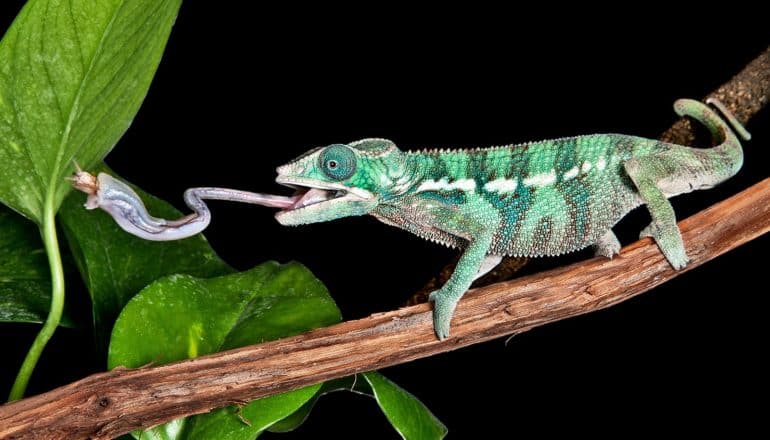
Getting inspiration from a chameleon’s tongue, researchers have created soft robots that can recreate high-powered and high-speed motions using stored elastic energy.
Chameleons, salamanders, and many toads use stored elastic energy to launch their sticky tongues at unsuspecting insects located up to one-and-a-half body lengths away, catching them within a tenth of a second.
The researchers made the robots using stretchable polymers similar to rubber bands, with internal pneumatic channels that expand upon pressurization. To store the elastic energy, the robots stretch their body in one or multiple directions during the fabrication process following nature-inspired principles.
Similar to the chameleon’s tongue strike, a pre-stressed pneumatic soft robot can expand five times its own length, catch a live fly beetle, and retrieve it in just 120 milliseconds.
“We believed that if we could fabricate robots capable of performing such large-amplitude motions at high speed like chameleons, then many automated tasks could be completed more accurately and in a much faster way,” says Ramses Martinez, an assistant professor in the School of Industrial Engineering and in the Weldon School of Biomedical Engineering at Purdue University.
“Conventional robots are usually built using hard and heavy components that slow down their motion due to inertia. We wanted to overcome that challenge.”
Reacts in 50 milliseconds
Many birds, like the three-toed woodpecker, achieve zero-power perching using the elastic energy stored in the stressed tendons at the back of their legs, allowing them to not fall off a perch when asleep.
The anatomy of these birds has served as an example to enable the fabrication of robotic grippers capable of zero power holding up to 100 times their weight and perching upside down from angles of up to 116 degrees.
This video shows how these bird-inspired soft robotic gripper catching a ball moving at 10 millimeters per second in only 65 milliseconds:
The conformability of the soft arms of these grippers to the gripped object maximizes contact area, enhancing grasping and facilitating high-speed catching and zero-power holding.
This video shows how these grippers can perch upside down from angles up to 116 degrees:
Some plants also know how to exploit elastic energy to achieve high-speed motion using “trap mechanisms.” The Venus flytrap uses the elastic energy stored in its bistable, curved leaves to rapidly close on prey exploring their inner surface.
This high-speed camera video shows the closure in a snap of this soft robotic Venus flytrap:
Inspired by the trap mechanism of the Venus flytrap and studying how lizards catch insects, researchers created a soft robotic Venus flytrap, which closes in only 50 milliseconds after receiving a short pressurized stimulus.
Super speeds
These new pre-stressed soft robots have several significant advantages over existing soft robotic systems, Martinez says. First, they excel at gripping, holding, and manipulating a large variety of objects at high speed. They can use the elastic energy stored in their pre-stressed elastomeric layer to hold objects up to 100 times their weight without consuming any external power.
Researchers can easily pattern their soft skin with anti-slip microspikes, which significantly increases their traction and allows them to perch upside down over prolonged periods of time and facilitates the capture of live prey.
“We envision that the design and fabrication strategies proposed here will pave the way toward a new generation of entirely soft robots capable of harnessing elastic energy to achieve speeds and motions currently inaccessible for existing robots,” Martinez says.
The paper appears in Advanced Functional Materials. Martinez and his team have worked with the Purdue Research Foundation Office of Technology Commercialization to patent some of his technologies related to robots and other design innovations.
Source: Purdue University
The post Chameleons’ weird speedy tongues inspire faster soft robots appeared first on Futurity.
from Futurity https://ift.tt/31TxDHB
No comments:
Post a Comment